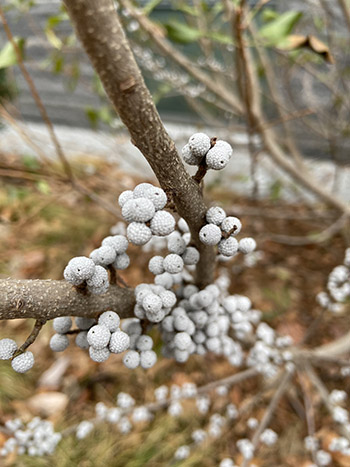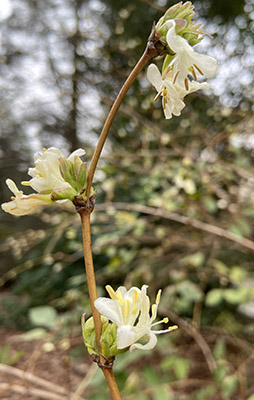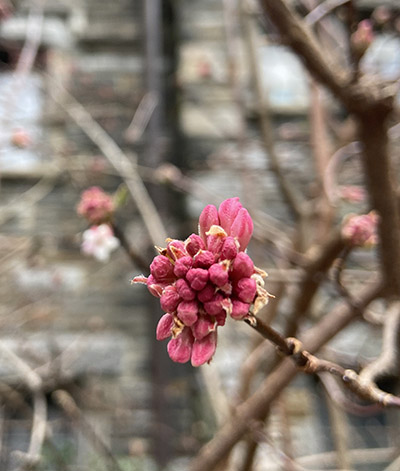
Plants of the Week: Jan. 23

Morella pensylvanica (northern bayberry)
In this mid-January garden, we are seeing an abundance of jewel-like red berries hanging from branches. It is very fitting for the season and certainly adds some brilliance to the otherwise slumbering landscape. But let’s be honest, every once in a while it’s nice to see some variety. For myself this variety came in the form of small grayish-white drupes of berries on the Morella (syn. Myrica) pensylvanica .
This eastern North American plant is a dense-branching shrub with an attractive round habit, usually found native in colonies or thickets bordering woods. It grows to a height of 5-7 feet with a spread of 5-10 feet. It is a wonderfully tolerant plant; growing in a wide range of soils and growing conditions, including poor soils, wet soils, drought, high winds, and salt spray.
Plant this shrub in groupings with at least one male for this plants to form attractive clusters of tiny, grayish-white fruits in late summer which will persist through April. Fruits are covered with an aromatic, waxy substance which are used to make bayberry candles, soaps, and sealing wax. These fruits are also attractive to birds and visitors. Enjoy the delightful clusters adding winter interest and dynamic color in the garden. Photo credit: M. Rossman

Lonicera x purpusii (Purpus honeysuckle)
Lately when I think of honeysuckles, I recall back to my time spent untangling vines from trees in the Crum Woods. But before my time here at the Scott Arboretum, the name honeysuckle would call to mind the sweetly scented lotion my mother would occasionally wear. I think this sentiment is true for most people; honeysuckle is more often thought of as a sweet scent, delighting perfumes, candles, and body products, rather than the invasive, plaguing woods across the United States. But if we want to hark back to more positive memories of honeysuckles, look no further than the Lonicera x purpusii, or the Purpus honeysuckle.
This plant, located near the Camelia Collection off of College Ave is a shrubby honeysuckle that grows as a bush rather than a climber. It has a lax growing habit that looks best when you allow it to grow into its own with plenty of space to develop.
Extremely attractive to insects, the Purpus honeysuckle bears intensely sweet, fragrant, creamy white flowers on bare stems. Typically, this plant would bloom in late February through March, but because everything is on an early timeline this winter, it has started to display its clusters of tubular flowers. We cannot ignore the fact that many Lonicera species are wreaking havoc with their invasive nature, but when visiting the Lonicera x purpusii it’s okay to pause and enjoy the delights of the honeysuckle scent. Photo credit: M. Rossman

Viburnum x bodnantense ‘Dawn’ (Bodnant viburnum)
The viburnum pinks are emerging, slowly but surely and a little early. One such viburnum with hints of flowers is the Viburnum x bodnantense ‘Dawn’.
Located on the northeast side of Wharton Hall, this Bodnant viburnum is a handsome upright, narrow, multi-stemmed shrub with a height of 8-10 feet and a spread of 4-6 feet. The Bodnant viburnum grows well in well-drained soils with medium moisture, in full sun to partial shade. Wet weather and frost may limit flowering display, plant this shrub in a protected location where it can still get plenty of sunlight in order to maximize flowering.
This hybrid viburnum cross between V. farreri and V. grandiflorum, was performed at Bodnant Garden in 1935-1935. Three cultivars were produced from this cross: ‘Charles Lamont’, noted for its dark pink flowers, ‘Deben’, which has a stiff habit and whitish-red flowers, and ‘Dawn’, our highlighted plant, which features an upright habit, and extremely fragrant, tubular, pink flowers. Photo credit: M. Rossman





No Comments